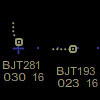This may be a little off-topic from my air traffic control simulations, but a comedy break is always a good thing. This is a brilliant Rick Moranis moment from the movie, “Space Balls”. There is nothing like a good cup of coffee while watching radar!
Monthly Archives: January 2010
Realism in Air Traffic Control Simulations
 One thing that I have come to realize after building more than five air traffic control simulations: You cannot simulate the real thing on a 19″ screen. There, I said it. My air traffic control simulation weighs in at an impressive 997×738 pixels, which is as large as I can make it while still serving the lowest common denominator. 20% of my customers are still running on a screen resolution of 1024×768, which makes it a tight fit. Any larger, and you wind up with the dreaded scroll bars.
One thing that I have come to realize after building more than five air traffic control simulations: You cannot simulate the real thing on a 19″ screen. There, I said it. My air traffic control simulation weighs in at an impressive 997×738 pixels, which is as large as I can make it while still serving the lowest common denominator. 20% of my customers are still running on a screen resolution of 1024×768, which makes it a tight fit. Any larger, and you wind up with the dreaded scroll bars.
A typical computer screen is simply not big enough to display an 80 mile-wide sector. With such an enormous range, you can’t vector airplanes. The details are too darn small. Since I can’t change your monitor into a 35-inch monstrosity, my simulation zooms you in on the action with its’ relatively small sector. It is only 40 nautical miles from edge-to-edge. Things happen pretty fast in a small sector like this one, and there is very little wiggle room when you get backed into a corner.
Air Traffic Control Radar Simulation
 I have received a number of emails lately, regarding my air traffic control radar simulation. Some of these emails are from real-world air traffic controllers who would like to see even more advanced features, such as auto-overs and amended missed approaches. Others are from buyers who are struggling just to get a handle on the simulation. One thing that I have tried to be upfront about is that this is not a game. It’s a sim. There is no ‘score’, there is no dramatic music and there are no ‘levels’. This air traffic control simulation was designed to be as real as possible, right down to the pilot voices that you hear.
I have received a number of emails lately, regarding my air traffic control radar simulation. Some of these emails are from real-world air traffic controllers who would like to see even more advanced features, such as auto-overs and amended missed approaches. Others are from buyers who are struggling just to get a handle on the simulation. One thing that I have tried to be upfront about is that this is not a game. It’s a sim. There is no ‘score’, there is no dramatic music and there are no ‘levels’. This air traffic control simulation was designed to be as real as possible, right down to the pilot voices that you hear.
